Industrial Management and Consultation Project: Gulf Integration
VerifiedAdded on 2020/04/15
|6
|861
|214
Report
AI Summary
This report presents an analysis of an Industrial Management and Consultation Project, focusing on Gulf Integration. It utilizes secondary research to examine the company's operations and its influence on the economic landscape, particularly within the context of Singapore and the Gulf Cooperation Council (GCC). The report incorporates data from various sources, including financial statements, trade investments, and macroeconomic indicators such as inflation rates, GDP, and exchange rates. It investigates the economic impact of Gulf Integration across different sectors, including real estate and retail, and explores the dynamics of monetary integration within the GCC. The report highlights the need for a supranational monetary institution and the importance of fiscal convergence, offering a comprehensive overview of the company's role in the global economy.
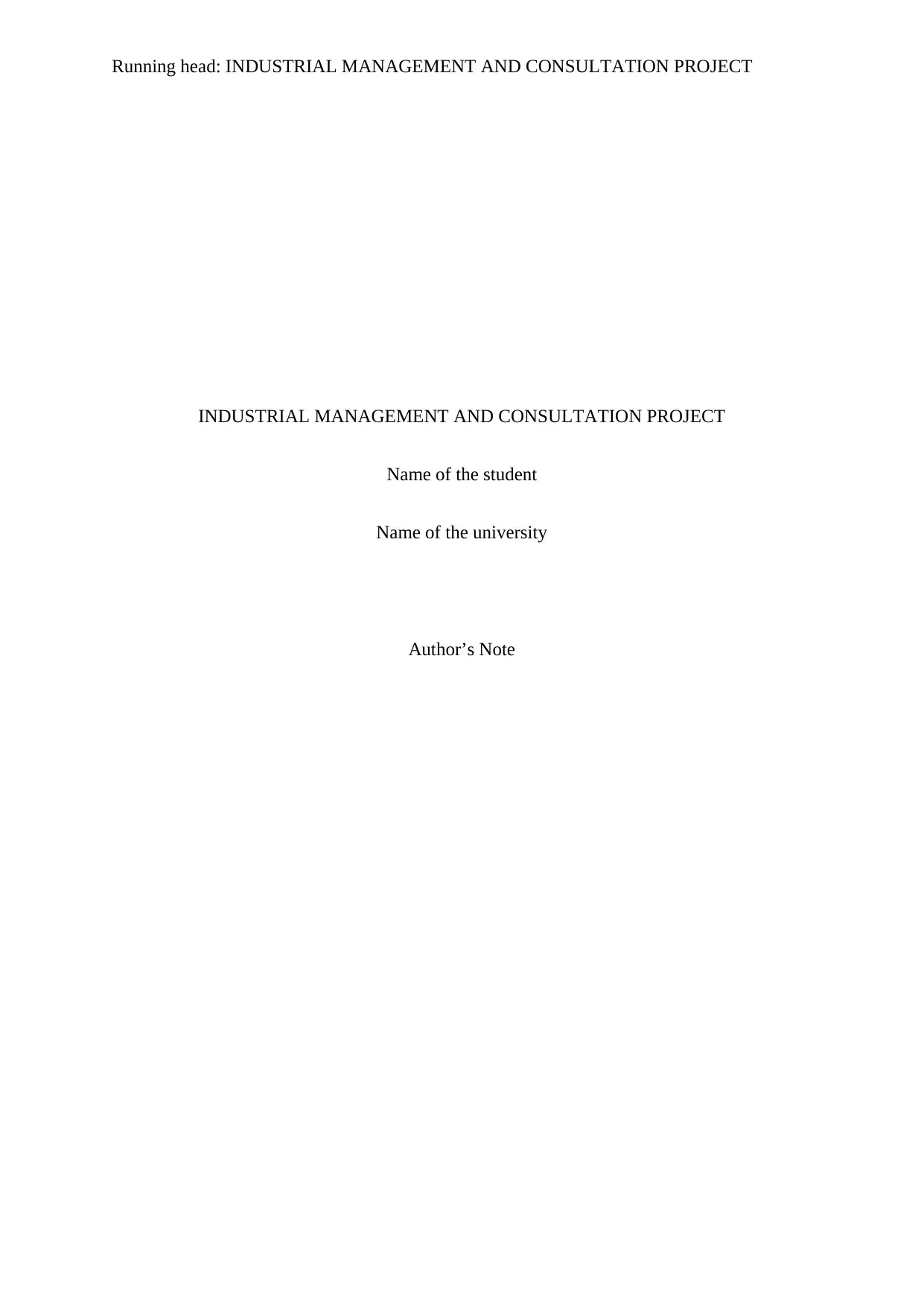
Running head: INDUSTRIAL MANAGEMENT AND CONSULTATION PROJECT
INDUSTRIAL MANAGEMENT AND CONSULTATION PROJECT
Name of the student
Name of the university
Author’s Note
INDUSTRIAL MANAGEMENT AND CONSULTATION PROJECT
Name of the student
Name of the university
Author’s Note
Paraphrase This Document
Need a fresh take? Get an instant paraphrase of this document with our AI Paraphraser
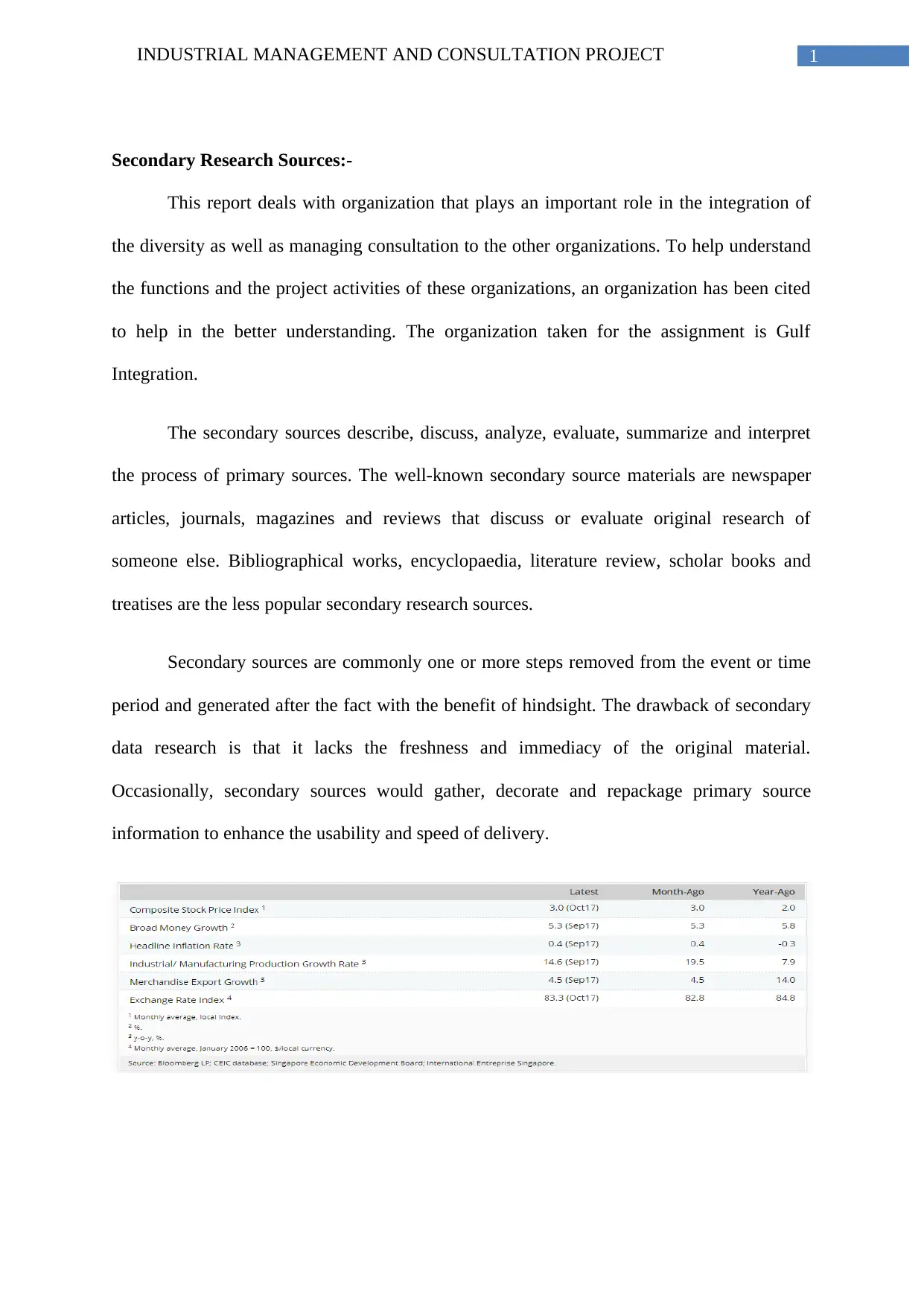
1INDUSTRIAL MANAGEMENT AND CONSULTATION PROJECT
Secondary Research Sources:-
This report deals with organization that plays an important role in the integration of
the diversity as well as managing consultation to the other organizations. To help understand
the functions and the project activities of these organizations, an organization has been cited
to help in the better understanding. The organization taken for the assignment is Gulf
Integration.
The secondary sources describe, discuss, analyze, evaluate, summarize and interpret
the process of primary sources. The well-known secondary source materials are newspaper
articles, journals, magazines and reviews that discuss or evaluate original research of
someone else. Bibliographical works, encyclopaedia, literature review, scholar books and
treatises are the less popular secondary research sources.
Secondary sources are commonly one or more steps removed from the event or time
period and generated after the fact with the benefit of hindsight. The drawback of secondary
data research is that it lacks the freshness and immediacy of the original material.
Occasionally, secondary sources would gather, decorate and repackage primary source
information to enhance the usability and speed of delivery.
Secondary Research Sources:-
This report deals with organization that plays an important role in the integration of
the diversity as well as managing consultation to the other organizations. To help understand
the functions and the project activities of these organizations, an organization has been cited
to help in the better understanding. The organization taken for the assignment is Gulf
Integration.
The secondary sources describe, discuss, analyze, evaluate, summarize and interpret
the process of primary sources. The well-known secondary source materials are newspaper
articles, journals, magazines and reviews that discuss or evaluate original research of
someone else. Bibliographical works, encyclopaedia, literature review, scholar books and
treatises are the less popular secondary research sources.
Secondary sources are commonly one or more steps removed from the event or time
period and generated after the fact with the benefit of hindsight. The drawback of secondary
data research is that it lacks the freshness and immediacy of the original material.
Occasionally, secondary sources would gather, decorate and repackage primary source
information to enhance the usability and speed of delivery.
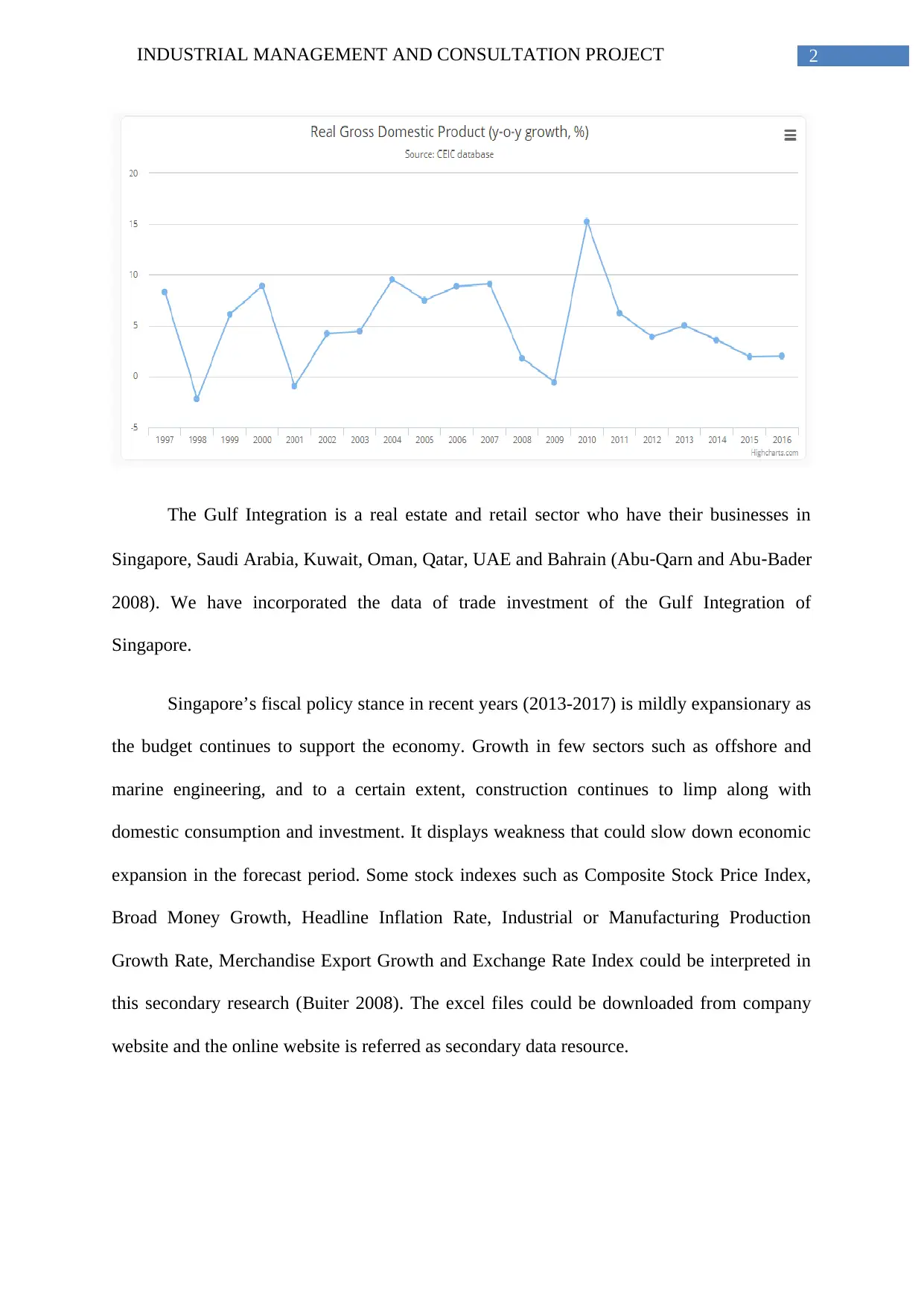
2INDUSTRIAL MANAGEMENT AND CONSULTATION PROJECT
The Gulf Integration is a real estate and retail sector who have their businesses in
Singapore, Saudi Arabia, Kuwait, Oman, Qatar, UAE and Bahrain (Abu‐Qarn and Abu‐Bader
2008). We have incorporated the data of trade investment of the Gulf Integration of
Singapore.
Singapore’s fiscal policy stance in recent years (2013-2017) is mildly expansionary as
the budget continues to support the economy. Growth in few sectors such as offshore and
marine engineering, and to a certain extent, construction continues to limp along with
domestic consumption and investment. It displays weakness that could slow down economic
expansion in the forecast period. Some stock indexes such as Composite Stock Price Index,
Broad Money Growth, Headline Inflation Rate, Industrial or Manufacturing Production
Growth Rate, Merchandise Export Growth and Exchange Rate Index could be interpreted in
this secondary research (Buiter 2008). The excel files could be downloaded from company
website and the online website is referred as secondary data resource.
The Gulf Integration is a real estate and retail sector who have their businesses in
Singapore, Saudi Arabia, Kuwait, Oman, Qatar, UAE and Bahrain (Abu‐Qarn and Abu‐Bader
2008). We have incorporated the data of trade investment of the Gulf Integration of
Singapore.
Singapore’s fiscal policy stance in recent years (2013-2017) is mildly expansionary as
the budget continues to support the economy. Growth in few sectors such as offshore and
marine engineering, and to a certain extent, construction continues to limp along with
domestic consumption and investment. It displays weakness that could slow down economic
expansion in the forecast period. Some stock indexes such as Composite Stock Price Index,
Broad Money Growth, Headline Inflation Rate, Industrial or Manufacturing Production
Growth Rate, Merchandise Export Growth and Exchange Rate Index could be interpreted in
this secondary research (Buiter 2008). The excel files could be downloaded from company
website and the online website is referred as secondary data resource.
⊘ This is a preview!⊘
Do you want full access?
Subscribe today to unlock all pages.

Trusted by 1+ million students worldwide
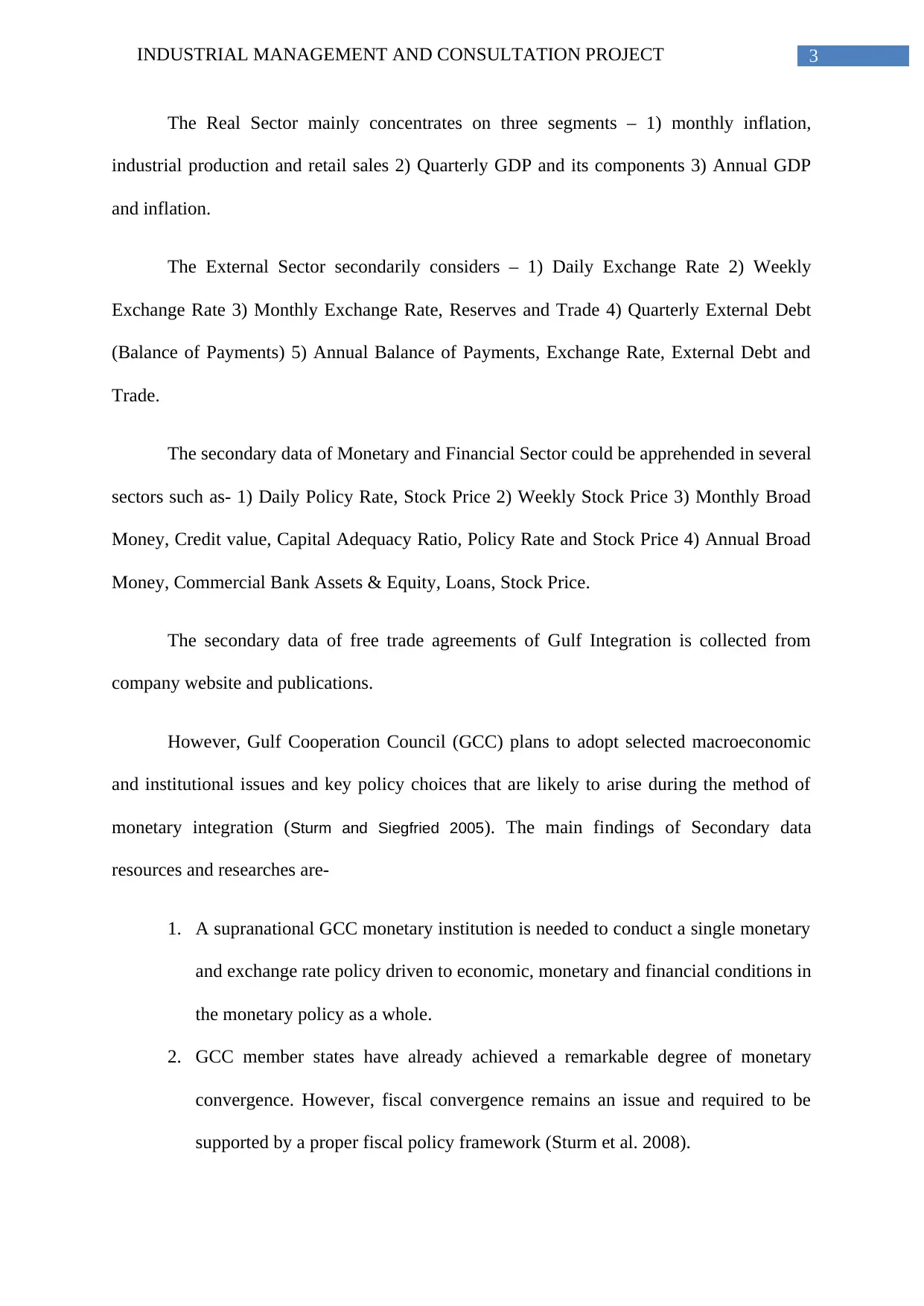
3INDUSTRIAL MANAGEMENT AND CONSULTATION PROJECT
The Real Sector mainly concentrates on three segments – 1) monthly inflation,
industrial production and retail sales 2) Quarterly GDP and its components 3) Annual GDP
and inflation.
The External Sector secondarily considers – 1) Daily Exchange Rate 2) Weekly
Exchange Rate 3) Monthly Exchange Rate, Reserves and Trade 4) Quarterly External Debt
(Balance of Payments) 5) Annual Balance of Payments, Exchange Rate, External Debt and
Trade.
The secondary data of Monetary and Financial Sector could be apprehended in several
sectors such as- 1) Daily Policy Rate, Stock Price 2) Weekly Stock Price 3) Monthly Broad
Money, Credit value, Capital Adequacy Ratio, Policy Rate and Stock Price 4) Annual Broad
Money, Commercial Bank Assets & Equity, Loans, Stock Price.
The secondary data of free trade agreements of Gulf Integration is collected from
company website and publications.
However, Gulf Cooperation Council (GCC) plans to adopt selected macroeconomic
and institutional issues and key policy choices that are likely to arise during the method of
monetary integration (Sturm and Siegfried 2005). The main findings of Secondary data
resources and researches are-
1. A supranational GCC monetary institution is needed to conduct a single monetary
and exchange rate policy driven to economic, monetary and financial conditions in
the monetary policy as a whole.
2. GCC member states have already achieved a remarkable degree of monetary
convergence. However, fiscal convergence remains an issue and required to be
supported by a proper fiscal policy framework (Sturm et al. 2008).
The Real Sector mainly concentrates on three segments – 1) monthly inflation,
industrial production and retail sales 2) Quarterly GDP and its components 3) Annual GDP
and inflation.
The External Sector secondarily considers – 1) Daily Exchange Rate 2) Weekly
Exchange Rate 3) Monthly Exchange Rate, Reserves and Trade 4) Quarterly External Debt
(Balance of Payments) 5) Annual Balance of Payments, Exchange Rate, External Debt and
Trade.
The secondary data of Monetary and Financial Sector could be apprehended in several
sectors such as- 1) Daily Policy Rate, Stock Price 2) Weekly Stock Price 3) Monthly Broad
Money, Credit value, Capital Adequacy Ratio, Policy Rate and Stock Price 4) Annual Broad
Money, Commercial Bank Assets & Equity, Loans, Stock Price.
The secondary data of free trade agreements of Gulf Integration is collected from
company website and publications.
However, Gulf Cooperation Council (GCC) plans to adopt selected macroeconomic
and institutional issues and key policy choices that are likely to arise during the method of
monetary integration (Sturm and Siegfried 2005). The main findings of Secondary data
resources and researches are-
1. A supranational GCC monetary institution is needed to conduct a single monetary
and exchange rate policy driven to economic, monetary and financial conditions in
the monetary policy as a whole.
2. GCC member states have already achieved a remarkable degree of monetary
convergence. However, fiscal convergence remains an issue and required to be
supported by a proper fiscal policy framework (Sturm et al. 2008).
Paraphrase This Document
Need a fresh take? Get an instant paraphrase of this document with our AI Paraphraser
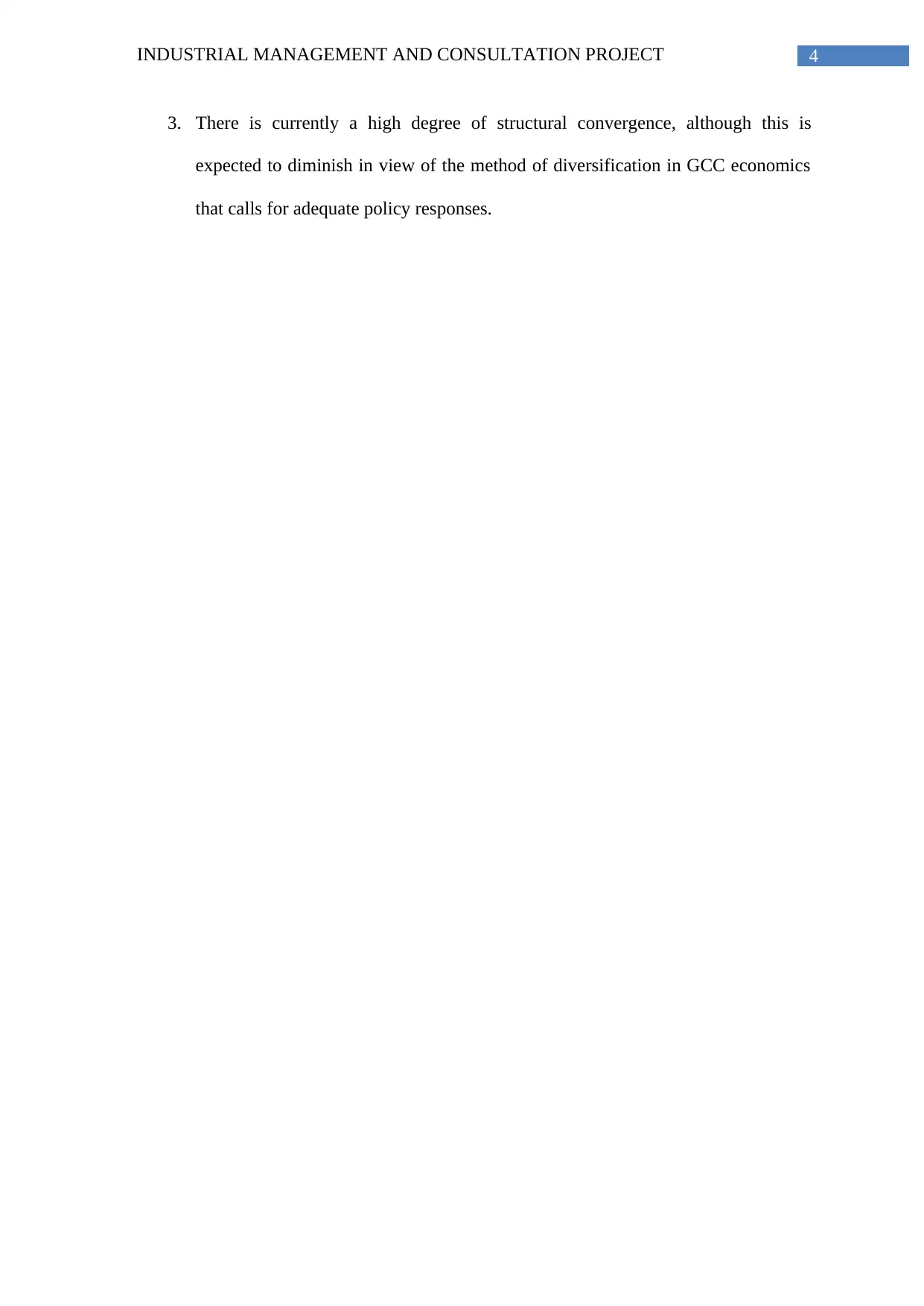
4INDUSTRIAL MANAGEMENT AND CONSULTATION PROJECT
3. There is currently a high degree of structural convergence, although this is
expected to diminish in view of the method of diversification in GCC economics
that calls for adequate policy responses.
3. There is currently a high degree of structural convergence, although this is
expected to diminish in view of the method of diversification in GCC economics
that calls for adequate policy responses.
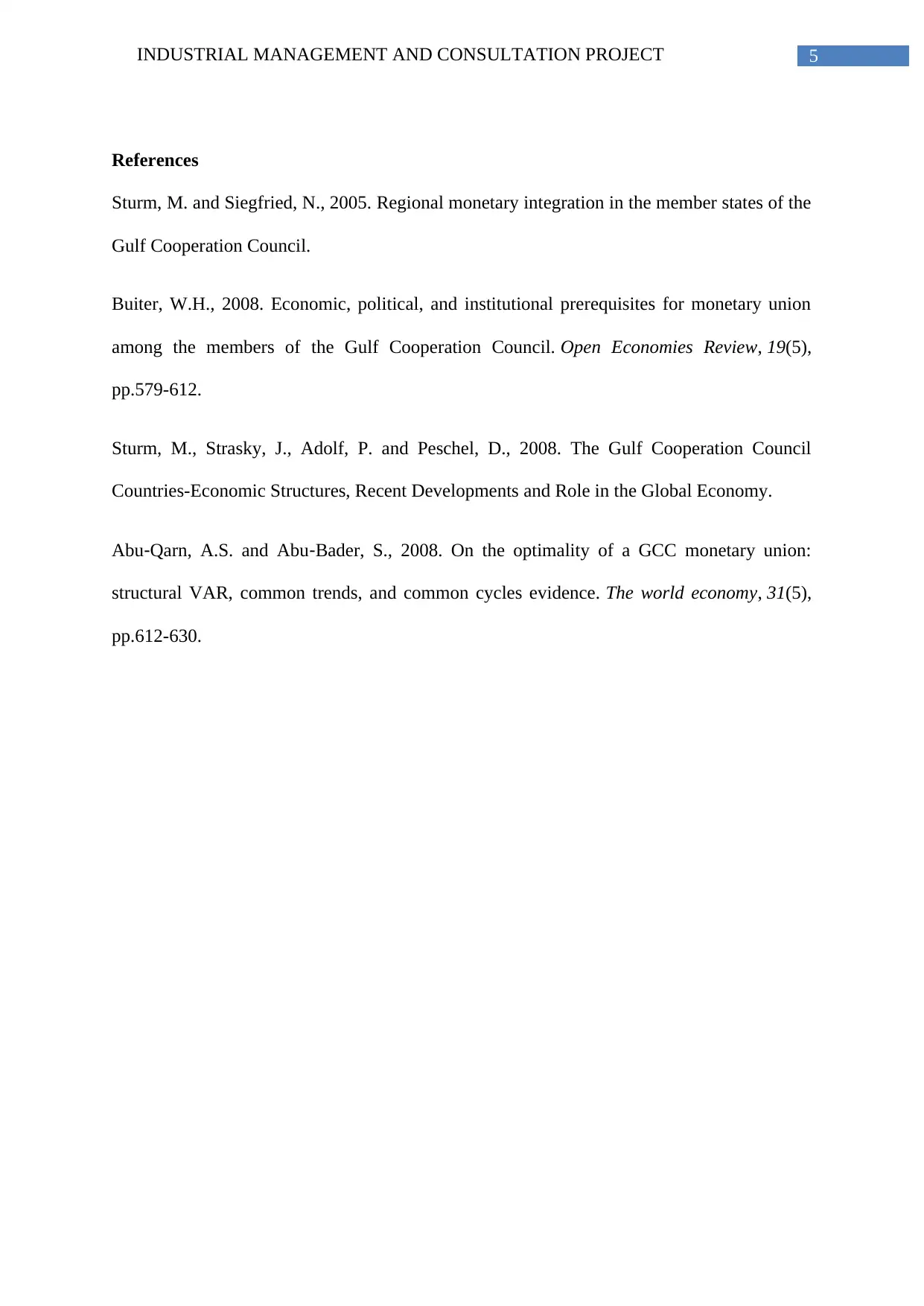
5INDUSTRIAL MANAGEMENT AND CONSULTATION PROJECT
References
Sturm, M. and Siegfried, N., 2005. Regional monetary integration in the member states of the
Gulf Cooperation Council.
Buiter, W.H., 2008. Economic, political, and institutional prerequisites for monetary union
among the members of the Gulf Cooperation Council. Open Economies Review, 19(5),
pp.579-612.
Sturm, M., Strasky, J., Adolf, P. and Peschel, D., 2008. The Gulf Cooperation Council
Countries-Economic Structures, Recent Developments and Role in the Global Economy.
Abu‐Qarn, A.S. and Abu‐Bader, S., 2008. On the optimality of a GCC monetary union:
structural VAR, common trends, and common cycles evidence. The world economy, 31(5),
pp.612-630.
References
Sturm, M. and Siegfried, N., 2005. Regional monetary integration in the member states of the
Gulf Cooperation Council.
Buiter, W.H., 2008. Economic, political, and institutional prerequisites for monetary union
among the members of the Gulf Cooperation Council. Open Economies Review, 19(5),
pp.579-612.
Sturm, M., Strasky, J., Adolf, P. and Peschel, D., 2008. The Gulf Cooperation Council
Countries-Economic Structures, Recent Developments and Role in the Global Economy.
Abu‐Qarn, A.S. and Abu‐Bader, S., 2008. On the optimality of a GCC monetary union:
structural VAR, common trends, and common cycles evidence. The world economy, 31(5),
pp.612-630.
⊘ This is a preview!⊘
Do you want full access?
Subscribe today to unlock all pages.

Trusted by 1+ million students worldwide
1 out of 6
Your All-in-One AI-Powered Toolkit for Academic Success.
+13062052269
info@desklib.com
Available 24*7 on WhatsApp / Email
![[object Object]](/_next/static/media/star-bottom.7253800d.svg)
Unlock your academic potential
Copyright © 2020–2025 A2Z Services. All Rights Reserved. Developed and managed by ZUCOL.


